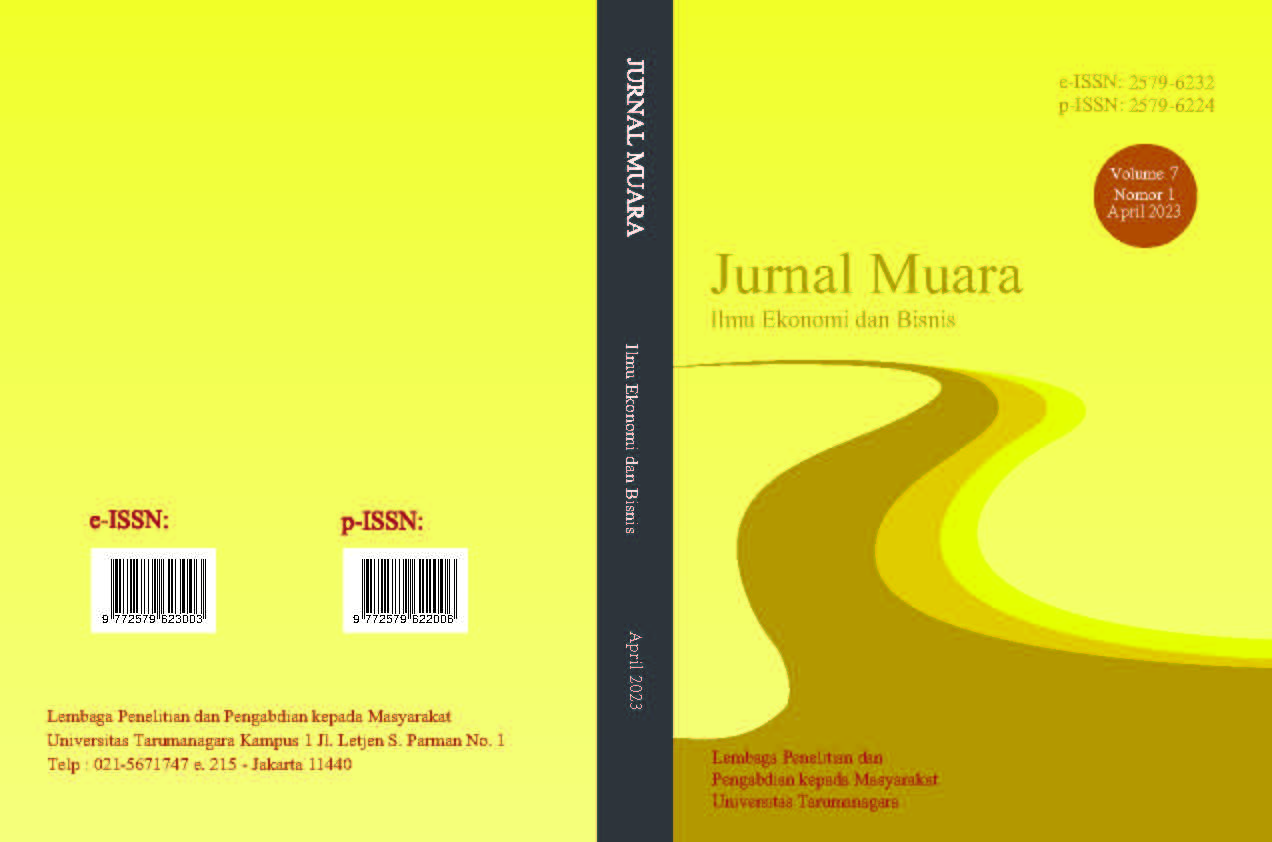THE ANALYSIS OF HIGHEST PAYING DIVIDEND COMPANIES STOCK RETURNS VOLATILITY IN INDONESIA
Main Article Content
Abstract
Penelitian ini bertujuan untuk memodelkan volatilitas return indeks saham perusahaan dividen tertinggi di Indonesia (DIV 20) sebelum dan sesudah pandemi COVID 19. Model keluarga ARCH (Autoregressive Conditional Heteroscedasticity) digunakan dalam hal ini. Periode penelitian diperpanjang dari 18 Mei 2018 hingga 18 Februari 2022. Batas waktu dimulainya pandemi adalah 1 April 2020. Data pengembalian adalah pengembalian mingguan. Hasilnya menunjukkan bahwa sebelum pandemi, GJR-GARCH(1,1) dapat memetakan dan melacak volatilitas dengan sangat baik karena mencetak AIC dan SIC pra-pandemi terendah. Oleh karena itu, penelitian ini menguatkan bukti adanya reaksi asimetris dari partisipasi pasar terhadap kemunculan dan penyebaran berita baik dan buruk di pasar. Setelah pandemi, efek ARCH menjadi kurang jelas. Angka signifikansi menurun meskipun efek ARCH masih signifikan pada 0,15. Performa model ARCH(1) secara signifikan lebih tinggi daripada model lain pasca-pandemi. Hasil tersebut menjadi bukti bahwa pascapandemi ketidakpastian yang dihadapi pelaku pasar sangat tinggi. Hal ini mengakibatkan meningkatnya volatilitas. Model keluarga ARCH menjadi kurang signifikan karena pengembaliannya lebih acak. Analisis lebih lanjut, bagaimanapun, menunjukkan bahwa pengembalian belum mengikuti model random walk meskipun keacakan meningkat. Oleh karena itu, ARCH(1) masih sesuai untuk memodelkan volatilitas setelah Pandemi.
This research aims at modeling the volatility of Indonesian highest paying dividend companies stock index (DIV 20) returns before and after pandemic COVID 19. The ARCH (Autoregressive Conditional Heteroscedasticity) family models were employed in this regard. The research period extended from 18 May 2018 to 18 February 2022. The cutoff for the commencement of pandemic was 1st April 2020. The return data were weekly returns. The results suggested that before pandemic, GJR-GARCH(1,1) could map and trace the volatility very well since it scored the lowest AIC and SIC pre-pandemic. Therefore, this research corroborated the evidence that there existed asymmetric reaction from the market participation toward the emergence and spread of good and bad news in the market. After pandemic, the ARCH effect became less obvious. The significance number was decreasing although the ARCH effect was still significant at 0.15. ARCH(1) model performance was significantly higher than the other models post-pandemic. The result presented evidence that after pandemic the uncertainty facing the market participants was very high. This resulted in the increase of the volatility. The ARCH family model was becoming less significant because the returns were more random. Further analysis, however, showed that the returns did not yet follow the random walk model despite the increasing randomness. Therefore, ARCH(1) was still appropriate to model the volatility after Pandemic.
Article Details

This work is licensed under a Creative Commons Attribution-NonCommercial-ShareAlike 4.0 International License.
This work is licensed under a Jurnal Muara Ilmu Ekonomi dan Bisnis Creative Commons Attribution-ShareAlike 4.0 International License.References
Aggarwal, R., Inclan, C., & Leal, R. (1999). Volatility in Emerging Stock Markets. Journal of Financial and Quantitative Analysis, 34(1), 33-55. doi:https://doi.org/10.2307/2676245
Amit & Bammi, R. (2016). Impact of News on Indian Stock Market: A Periodic Study with Asymmetric Conditional Volatility Models. Management and Labour Studies, 41(3), 169-180. doi:https://doi.org/10.1177%2F0258042X16666575
Andika, T., Fahmi, I., & Andati, T. (2019). The Macroeconomic Surprise Effects on LQ45 Stock Return Volatility. Jurnal Aplikasi Manajemen, 17(2), 235-243. doi:http://dx.doi.org/10.21776/ub.jam.2019.017.02.06
Emenike, K. O., & Enock, O. N. (2020). How Does News Affect Stock Return Volatility in a Frontier Market? Management and Labour Studies, 45(4), 433-443. doi:https://doi.org/10.1177%2F0258042X20939019
Hansen, P. R., & Lunde, A. (2005). A Forecast Comparison of Volatility Models: Does Anything Beat a GARCH(1,1)? Journal of Applied Econometrics, 20(7), 873-889. doi:https://doi.org/10.1002/jae.800
Kingsley, A., & Peter, U. (2019). Volatility Modelling Using ARCH and GARCH Models: A Case Study of the Nigerian Stock Exchange. International Journal of Mathematics, Trends, and Technology, 65(4), 58-63. doi:http://dx.doi.org/10.14445/22315373/IJMTT-V65I4P511
Kurniasari, F., & Reyes, J. (2020). Determinants of LQ45 Index Banking Stock Price Volatility. Ultima Management: Jurnal Ilmu Manajemen, 12(2), 261-274. doi:https://doi.org/https://doi.org/10.31937/manajemen.v12i2.1771
Lee, S.-N., Hooy, C.-W., & Taib, F. M. (2019). The Effect of Corporate Governance on Firm Stock Volatility in Asia. Journal of Asia-Pacific Business, 25-47. doi:https://doi.org/10.1080/10599231.2019.1572421
Nazir, M. S., Nawaz, M. M., Anwar, W., & Ahmed, F. (2010). Determinants of Stock Price Volatility in Karachi Stock Exchange: The Mediating Role of Corporate Dividend Policy. International Research Journal of Finance and Economics (55)
Niewinska, K. (2020). Factors Affecting Stock Return Volatility in the Banking Sector in the Euro Zone. Journal of Economics and Management, 39(1), 132-148. doi:https://doi.org/10.22367/jem.2020.39.07
Nugroho, A. D., & Robiyanto, R. (2021). Determinant of Indonesian Stock Market's Volatility During the Covid-19 Pandemic. Jurnal Keuangan dan Perbankan, 25(1), 1-20. doi:https://doi.org/10.26905/jkdp.v25i1.4980
Nugroho, D. B., Pamungkas, B. A., & Arini, P. H. (2020). Volatility Fitting Performance of QGARCH(1,1) Model with Students-t, GED, and SGED Distributions. COMTECH: Computer, Mathematics, and Engineering Applications, 11(2), 97-104. doi:https://doi.org/10.21512/comtech.v11i2.6391
Ramasamy, R., & Munisamy, S. (2012). Predictive Accuracy of GARCH, GJR, and EGARCH Models Select Exchange Rates Application. Global Journal of Management and Business Research, 12(15)
Rodriguez, G. (2017). Selecting Between Autoregressive Conditional Heteroscedasticity Models: An Empirical Application to the Volatility of Stock Returns in Peru. Revista de Analisis Economico, 32(1), 69-94
Sari, L. K., Achsani, N. A., & Sartono, B. (2017). Pemodelan Volatilitas Return Saham: Studi Kasus Pasar Saham Asia. Jurnal Ekonomi dan Pembangunan Indonesia, 18(1), 35-52. doi:https://doi.org/10.21002/jepi.v18i1.717
Wulandari, R. (2021). Comparison of Volatility and Performance of Shares in Indonesia, Malaysia, China, and America. Asian Management and Business Review, 1(1), 46-56. doi:10.20885/AMBR.vol1.iss1.art5
Xie, F., Anderson, H. D., Chi, J., & Liao, J. (2019). Does Residual State Ownership Increase Stock Return Volatility? Evidence from China's Secondary Privatization. Journal of Banking & Finance, 100, 234-251. doi:https://doi.org/10.1016/j.jbankfin.2019.01.012
Yong, J. N., Ziaei, S. M., & Szulczyk, K. R. (2021). The Impact of COVID-19 Pandemic on Stock Market Return Volatility: Evidence from Malaysia and Singapore. Asian Economic and Financial Review, 11(3), 191-204. doi: 10.18488/journal.aefr.2021.113.191.204



